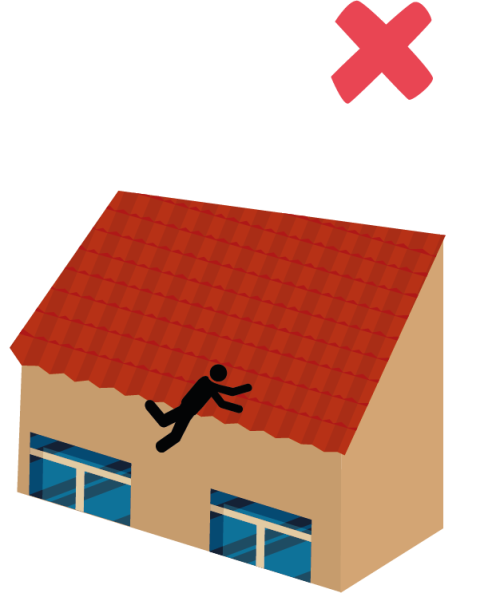
What risks can arise when working at height and over free depth?
Working at height and over free depth is a high-risk activity, with possible occupational injuries often being serious and fatal. Risks include:
- falls of persons from free edges of roofs, Obrázek

- falls of persons through uncovered openings or falls of persons through insufficiently load-bearing structures,
- falls of persons from unsecured edges of building structures and scaffolding, Obrázek
 Obrázek
Obrázek
- falls of material or objects on persons from heights. Obrázek
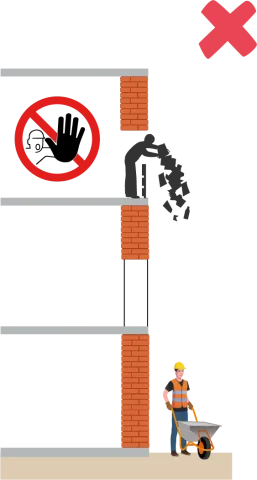
The following happened: occupational injury of a foreigner at work at height and over free depth
A worker with Ukrainian nationality (†18) was carrying out cleaning work on a flat metal roof. For reasons unknown, he unhooked himself from the safety rope and moved the cover plate that protected the area of the future lightwell. The worker fell from a height of 14 meters into the hall area. The injuries to the body and head were incompatible with life.
A worker of Slovak nationality (†37) climbed onto a roof structure after lunch to secure covering sheets with his colleagues. He did not strap himself to the anchor point and went to the edge of the structure for a cordless drill, subsequently falling off the edge of the roof for unknown reasons.
What is work at height and how must employees be protected?
Work at height and over free depths: work and movement of a worker, during which they are at risk of falling from height into depth, through collapse or subsidence. During these activities, the worker must be secured against falling, either by collective or personal protection. Work at any height is considered to be work at height, but when working at heights from 1.5 m, the employer must ensure that workers are protected against falls from height. 
Collective protection: for example, protective railings and fencing, hatches, catch scaffolding, fencing, or nets and temporary construction structures, such as scaffolding or work platforms. The requirements for these are specified in the relevant technical standards (ČSN EN). In addition to the standard requirements, it is also necessary to follow the installation and use instructions supplied with these structures, as well as specifically designed technological procedures.
Personal protection: Personal protective equipment (PPE) against falls is used in those cases where the nature of the work does not allow or significantly complicates the use of a technical structure.
"Ten Commandments" of safety when working at heights
FALL PROTECTION
- Employees must not be exposed to the risk of falling from a height at the workplace or on a road with a floor located higher than 0.5 m above the surrounding floor or terrain. Safe access must be provided for this purpose.
- Employees must be protected from falling:
- in all workplaces and access roads located above water or other substances endangering life or health in the event of a fall;
- in other cases, protection is necessary in the event of a risk of falling from a height or into depth greater than 1.5 m;
- when working on ladders, protection against falling is required from above 5 m.
- If the worker does not have to approach the fall edge (the so-called free edge) at a distance less than 1.5 m and the area slope does not exceed 10°, it is sufficient to demarcate the workplace with a simple barrier that does not have to meet load requirements as a handrail.
If there is a low wall at the free edge, for example, a parapet, this wall can be considered as fall protection from a height of 0.6 m, provided that the work being performed concerns this wall.
Obrázek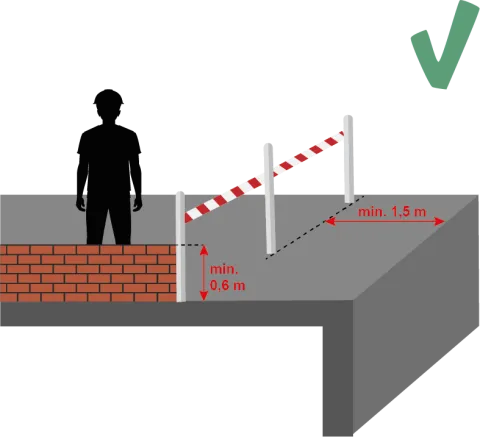
- Fall protection does not need to be installed along the free edges of openings, where at least one dimension does not exceed 0.25 m.
Floor openings whose dimensions in all directions exceed 0.25 m must be covered with hatches of appropriate load capacity secured against shifting, or secured by a technical means of fall protection, e.g. railing or fencing.
Obrázek Obrázek
Obrázek
- Openings in walls with dimensions larger than 0.3 m x 0.75 m and a lower edge lower than 1.1 m must be secured if there is a risk of falling into a depth greater than 1.5 m.
Unstable objects or objects intended for other uses (e.g., chairs, tables, buckets, etc.) must not be used to increase the height of the work or exit area!
Obrázek
- Work at height must be interrupted in adverse weather conditions! Severe weather conditions:
- visibility of less than 30 m;
- winds above 11 m/s;
- when working on mobile scaffolds, ladders above 5 m, suspended platforms and on ropes, it is necessary to stop working at wind speeds of 8 m/s;
- storms, rain, snow and icing;
- ambient temperature below -10 °C.
RAILINGS
- The height of railing is at least 1.1 m, unless otherwise specified in specific regulations. European standards (ČSN EN) allow a minimum height of railings of 1.0 m for temporary construction structures (e.g. scaffolding).
- An integral part of the railing is also a floor stop at least 0.15 m high.
- If the height of the floor above the surrounding level is greater than 2.0 m, the railing must be fitted with one or more central bars to prevent persons from falling in, or with other suitable paneling.
Protective railing of scaffolding according to the requirements of Government Regulation No. 362/2005 Coll. and ČSN 73 81066:
Obrázek
WORK ON ROOFS
- When working on roofs, it is necessary to protect employees from:
- falling from roof cladding on free edges;
- slipping from the roof at a slope above 25°;
- falling through the roof structure.
- If the roof slope exceeds 45°, workers must always be secured with personal protective equipment against falling.
SCAFFOLDING
- Technical documentation including assembly and disassembly instructions shall be available for each scaffold.
- During assembly, operation, and disassembly of scaffolding, safe traffic, including pedestrian movement on adjacent roads, must be ensured in its immediate vicinity.
- Scaffolding can only be installed on sufficiently load-bearing terrain to accommodate the loads imposed by the scaffolding and its future operation.
- Scaffolding shall be sufficiently rigid in the longitudinal, transverse and horizontal planes, with rigidity provided in accordance with the documentation by diagonal bracing, frames, etc.
- Scaffolding must be correctly anchored; anchor placement and load capacity must be in accordance with documentation; poor anchoring is the most common cause of accidents.
All working scaffolding floors above 2 m must be fitted with a double-bar railing with a stop.
Obrázek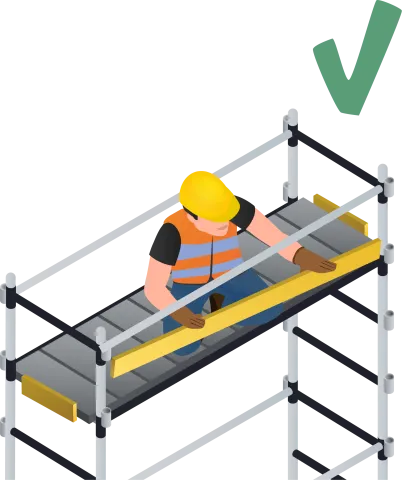
.
- If the height of the working floor above the adjacent surroundings is from 1.5 m to 2 m, the railing may be single-pole.
- Scaffolding floor elements must be non-slip, secured against lifting and shifting.
- If the distance between the scaffolding floor and the structure’s wall is greater than 0.25 m, there must be railing on the inner edge; if the width of the free opening is not greater than 0.4 m, this railing may be single-bar without a floor stop.
- Access ladders to scaffolding must exceed the upper landing surface level by at least 1 m. A fixed part of the structure that can be gripped reliably may replace the ladder overhang; it is not allowed to step on the overhanging part of the ladder.
- The minimum walk-through height of the scaffolding floor at the cross-linkage point is 1.75 m, in other places it is 1.9 m; the ground floor pedestrian underpass must have a clearance of at least 2.1 m.
- Scaffolding may be used only after its complete completion and written handover.
- Scaffolding shall be checked before work begins and at intervals specified by its documentation; specialist inspections are usually carried out monthly.
- Materials, tools and work aids when working at height are stored in such a way as to prevent them from dropping or slipping unintentionally.
The material must not overload the respective structure!
Obrázek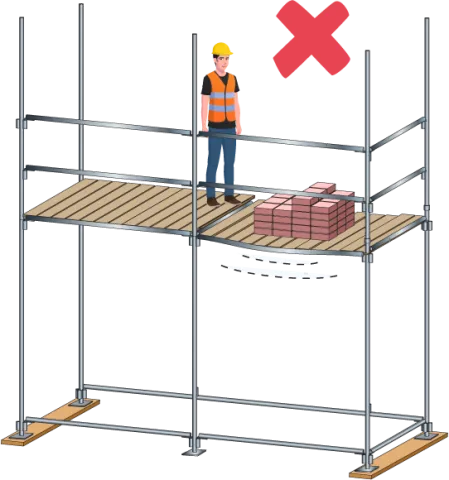
DANGER ZONE
- Make sure to secure space under the work area! Securing can be possible, for example, by avoiding traffic; construction at or just below the work site; fencing off the danger zone with a railing of 1.1 m height; guarding the danger zone by a designated person.
- The width of the danger zone from the free edge of the workplace depends on the height of the work area:
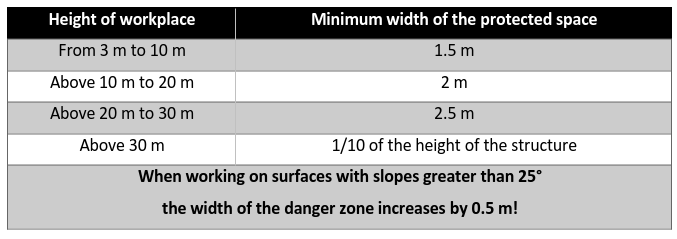
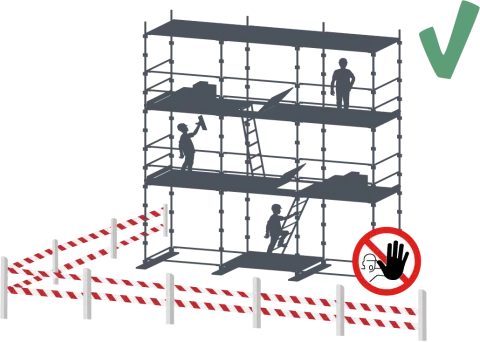
PPE
- The selected PPE against falling from a height must correspond to the nature of the work, risks, and weather conditions, allowing safe movement. Only PPE that meets the requirements of Government Regulation No. 21/2003 Coll. can be used.

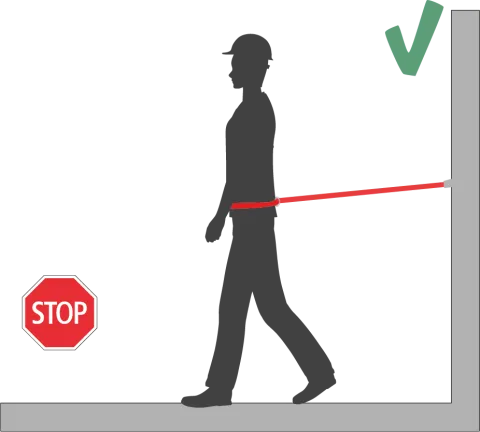
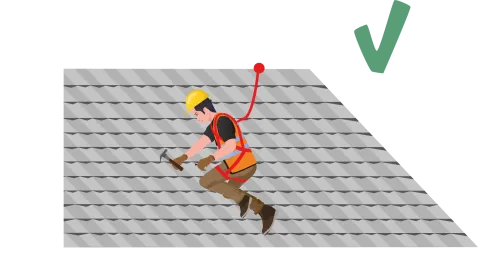
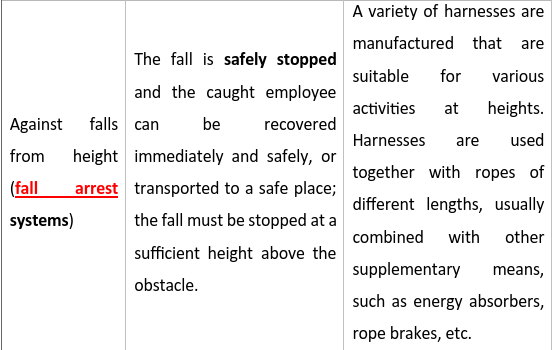
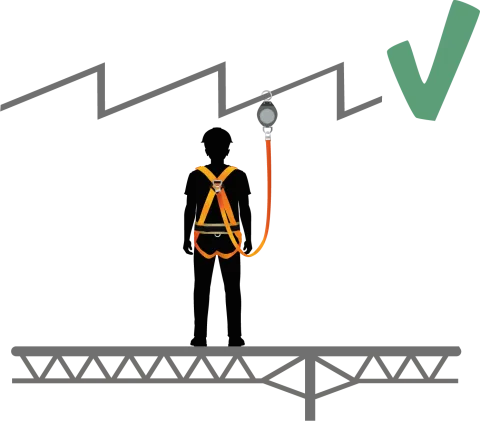

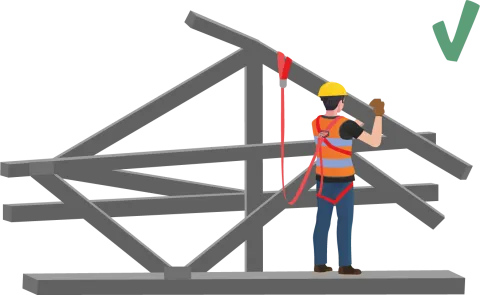
- The PPE must be CE marked and accompanied by instructions containing all requirements for use, adjustment, inspection, maintenance, storage, etc.; the equipment must also be handled in accordance with these instructions.
- The processor of the technological procedure, or the worker who manages work at heights, is obliged to designate an anchor point for the personal protection device. The anchor point must be sufficiently load-bearing.
- Before each use and after use, the worker must perform a visual inspection of the PPE used.
- Professional inspections and function tests of the operated PPE are conducted according to the manufacturer's instructions.
- The employer provides employees with sufficient training on OSH at heights and over free depths, especially for work at heights above 1.5 m, where employees cannot work from fixed and safe working floors, when they work on moving platforms, on ladders at a height above 5 m. The employer also provides training on the use of PPE. The training should also include information on how to proceed in the event of a fall from height and the need to rescue the affected person.
- Workers must be medically fit to work at height and over free depth using PPE. Decree No. 79/2013 Coll. lists diseases excluding medical fitness for this work. This is work with professional risk, which is subject to stricter conditions, including periodic examinations.
More detailed requirements for safety when working at heights and over free depths can be found here:
Section 3.3.4 of the Annex to Government Regulation No. 101/2005 Coll., on more detailed requirements for workplaces and work environment
Decree No. 79/2013 Coll., on occupational health services and certain types of assessment care)
Technical standards ČSN EN